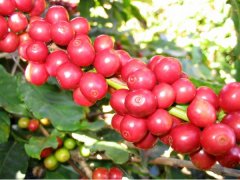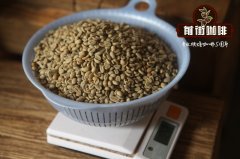How does coffee smell? Roasting curves differ for coffee, if the best roasting is found?
For professional baristas, please follow the coffee workshop (Wechat official account cafe_style)
The aroma of coffee comes from coffee roasting
The aroma and taste of coffee are produced after roasting. In the process of baking, the moisture of raw coffee beans is slowly released, the weight is reduced, the color deepens, the volume expands, and the aromatic oil is slowly released. In addition, a large amount of chlorogenic acid originally contained in raw beans will gradually disappear with the baking process, releasing good-smelling fruit acid, and its taste varies with the baking time. In the following picture, you can see the change in the shape of coffee beans during roasting.
The flavor of coffee
Before we get to the point, let's get to know a few proper terms to describe the flavor of coffee:
Acidity (acidity): the stimulation felt at the edge of the tongue when drinking coffee. Unlike the acid of lemon, coffee is a refreshing, refreshing feeling that boosts the taste, sometimes called brightness. Acidity is a very important characteristic of coffee, coffee without acidity will be very insipid.
Aroma: the aroma of brewed coffee is more varied than that felt by the tongue. The adjectives commonly used to describe the aroma of coffee are fruit-like, earthy, smoky, flowery, berries, nuts and so on.
Body: the taste of coffee in the mouth, from light as water or skim milk to thick as milk or cream, syrup.
Aftertaste: similar to the concept of wine tasting, refers to the taste that remains in the mouth after drinking coffee. Some coffee has the aftertaste of cocoa or chocolate, while others have fruit, berries, nuts and so on.
Balance (balance): this is an assessment of the overall taste of coffee. Good beans have a balanced, layered, and soft aroma, while bad beans usually show a single flavor.
In addition to the above proper nouns, there are several common adjectives that describe high-quality coffee:
Mellow: coffee with low to medium acidity and good balance.
Mild (mild): indicates that coffee has a harmonious, delicate flavor, usually refers to high-altitude South American coffee.
Soft: low-acidity, slightly sweet coffee, usually Indonesian coffee.
After knowing the term to describe the flavor of coffee, let's take a look at what factors affect the taste of coffee.
Baking degree
Baking is a process of heating beans. Unbaked raw beans smell only a little grassy and slightly fruity, but taste almost meaningless. Through the heating process, baking causes a series of complex chemical changes inside the beans, which in turn releases the various flavors that were originally locked in the raw beans.
Loring Smart Roaster S15 @ Luguo Cafe
Pot coffee Loring Smart Roaster S15, the machine itself can provide an endless source of stable heat, full performance of the beautiful melody and melodious echo of the production area, better able to recover the waste gas produced by roasting, and remove the annoying smoke and smell produced by coffee roasting in the roasting process, it is the most environmentally friendly bean roaster at present.
With regard to the importance of coffee roasting, there is a saying that the baker determines 80% of the flavor, while the pot coffee thinks that the nature of the raw beans is good enough, and the baker will want to retain more local layers of origin, so the closer it is to the flavor of the producing area, it is not easy to take into account the roaster's baking style.
According to the different heating time and speed, it can be divided into different baking degrees. The most common and easiest method is to divide it into shallow, medium and deep ones, with the following features:
Shallow baked Light Roast
In recent years, the trend of boutique coffee is mostly towards shallow roasting, because shallow roasting can not only retain the most acidity and aroma, but also retain the most flavor from the producing areas, that is, the growing environment of coffee, which brings unique personality to beans. Coffee beans appear light brown in appearance and will not have a glossy finish.
Medium baked Medium Roast
Coffee beans to the degree of roasting, will begin to produce "caramelization" phenomenon, the acid begins to weaken, mellow taste stronger, so there is a sweet taste, coffee beans will have a little bit of oil on the surface.
Deep baked Dark Roast
The deeper the baking, the more you need to rely on the experience and skills of the baker, so the more you can show the personal color of the baker, usually with a thick taste and throat rhyme. The deeper the baking, the more obvious the bitterness, and the bean surface will be glossy, dark brown, or even close to charcoal black.
Small finishing: baking degree, flavor and caffeine
The shallower the more sour, the deeper the bitterness
The shallower it is, the more characteristics of the producing area are retained, and the deeper the bean baker is, the more personal display of the baker.
In principle, the deeper the caffeine content, the less it is.
The sound of baking
If you go to a coffee shop and there happens to be a bean roaster, it's easy to hear beans beeping as they are roasted. Coffee beans have two opportunities to make a sound when they are heated, which are called "first explosion" and "second explosion" (First Crack and Second Crack).
First explosion of First Crack
This is because of the heat, which produces a large amount of gas and water vapor inside the beans. when the internal pressure cannot hold up, the volume of the beans expands and then bursts. An explosion occurs when the baking temperature is about 196Mel 205 °C, and the sound is so loud that it sounds a bit like popcorn, judging that the beans have begun to reach the level of shallow baking. Between the first explosion and the second explosion, it belongs to medium baking.
Second explosion Second Crack
If the heating continues at this time, a relatively subtle sound belonging to the second explosion will be heard while the temperature continues to rise, and the baking temperature is about 225mi 230 °C. After the second explosion begins, the oil of the beans will surface, that is, the stage of deep baking. Curious you may wonder what will happen if you continue to bake. Of course, because of carbonization, it finally burned up.
Cooling
Roasted coffee beans must be cooled quickly to prevent self-baking. Professional bean roasting machines on the market now have special cooling trays, but when roasting in large quantities in multiple batches, it is still necessary to pay attention to the change of coffee temperature after roasting.
Static
Roasted coffee beans have different resting time requirements depending on the heating mode of the roasting machine, just like fried steak, the coffee flavor will be better after the roasting!
Roasting degree of pot coffee
Shallow baking: the first explosion starts ~ close to the second explosion.
Medium baking: end of first explosion ~ dense second explosion
Deep baking: second explosion dense ~ second explosion end
Important Notice :
前街咖啡 FrontStreet Coffee has moved to new addredd:
FrontStreet Coffee Address: 315,Donghua East Road,GuangZhou
Tel:020 38364473
- Prev

Analysis of Ethiopian Beans and Distinction between Characteristic Flavor and Growing Environment
Professional barista exchanges, please pay attention to coffee workshop (Weixin Official Accounts cafe_style) Ethiopia related recommendations Sidamo Guji sun IMPCT public welfare joint light baking, fruity, berry aroma, around the nose sweet and sour, all the proceeds donated to IMPCT social cause preschool education fund Ye Jia Xue Fei Hai La Si Ke Chi sun light baking, lemon, citrus, tea, roasted sweet potato, this
- Next

Tips on how coffee beans are roasted
Professional barista communication Please pay attention to the internal structure of coffee workshop (Weixin Official Accounts cafe_style) Coffee fruit will become our common green coffee green beans after harvesting and preliminary treatment. At this time, the green beans still contain more moisture inside, so it needs to be roasted to evenly dry the moisture inside. Green coffee beans (the seeds of coffee) are usually made of two seeds.
Related
- Beginners will see the "Coffee pull flower" guide!
- What is the difference between ice blog purified milk and ordinary milk coffee?
- Why is the Philippines the largest producer of crops in Liberia?
- For coffee extraction, should the fine powder be retained?
- How does extracted espresso fill pressed powder? How much strength does it take to press the powder?
- How to make jasmine cold extract coffee? Is the jasmine + latte good?
- Will this little toy really make the coffee taste better? How does Lily Drip affect coffee extraction?
- Will the action of slapping the filter cup also affect coffee extraction?
- What's the difference between powder-to-water ratio and powder-to-liquid ratio?
- What is the Ethiopian local species? What does it have to do with Heirloom native species?

